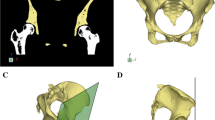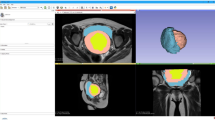Abstract
Introduction and hypothesis
The objective of this study was to assess the performance of a semiautomated pelvic floor measurement algorithmic model on dynamic magnetic resonance imaging (MRI) images compared with manual pelvic floor measurements for pelvic organ prolapse (POP) evaluation.
Methods
We examined 15 MRIs along the midsagittal view. Five reference points used for pelvic floor measurements were identified both manually and using our semiautomated measurement model. The two processes were compared in terms of accuracy and precision.
Results
The semiautomated pelvic floor measurement model provided highly consistent and accurate locations for all reference points on MRI. Results also showed that the model can identify the reference points faster than the manual-point identification process.
Conclusion
The semiautomated pelvic floor measurement model can be used to facilitate and improve the process of pelvic floor measurements on MRI. This will enable high throughput analysis of MRI data to improve the correlation analysis with clinical outcomes and potentially improve POP assessment.






Similar content being viewed by others
References
Dallenbach P, Kaelin-Gambirasio I, Jacob S, Dubuisson JB, Boulvain M (2008) Incidence rate and risk factors for vaginal vault prolapse repair after hysterectomy. Int Urogynecol J 19(12):1623–1629
Mouritsen L, Larsen JP (2003) Symptoms, bother and POPQ in women referred with pelvic organ prolapse. Int Urogynecol J Pelvic Floor Dys Funct 14:122–127
Bump RC, Mattiasson A, Bo K, Brubaker LP, DeLancey JOL, Klarskov P, Shull BL, Smith ARB (1996) The Standardization of Terminology of Female Pelvic Organ Prolapse and Pelvic Floor Dysfunction. Am J Obstet Gynecol 175(1):10–17
Colaiacomo MC, Masselli G, Polettini E, Lanciotti S, Casciani E, Bertini L, Gualdi G (2009) Dynamic MR imaging of the pelvic floor: a pictorial review. Radiographics 29:e35. doi:10.1148/rg.e35
Weber AM, Walters M (2001) D., Piedmonte, M. R., Ballard, L. A. Anterior colporrhaphy: A randomized trial of three surgical techniques. Am J Obstet Gynecol 185:1299–1306
Ginath S, Garely A, Luchs JS, Shahryarinejad A, Olivera C, Zhou S, Ascher-Walsh C, Condrea A, Brodman M, Vardy M (2011) MRI pelvic landmark angles in the assessment of apical pelvic organ prolapse. Arch Gynecol Obstet 284:365–370
Vierhout ME, Stoutjesdijk J, Spruijt J (2005) A comparison of preoperative and intraoperative evaluation of patients undergoing pelvic reconstructive surgery for pelvic organ prolapse using the pelvic organ prolapse quantification system. Int Urogynecol J 17:46–49
Vineyard DD, Kuehl TJ, Coates KW, Shull BL (2002) A comparison of preoperative and intraoperative evaluations for patients who undergo site-specific operation for the correction of pelvic organ prolapse. Am J Obstet Gynecol 186:1155–1159
Goh V, Halligan S, Kaplan G, Healy JC, Bartram CI (2000) Dynamic MR imaging of the pelvic floor in asymptomatic subjects. AJR Am J Roentgenol 174:661–666
Healy JCHS, Reznek RH (1997) Dynamic MR imaging compared with evacuation proctography when evaluating anorectal configuration and pelvic floor movement. AJR Am J Roentgenol 169:775–779
Lienemann AAC, Baron A, Kohn P, Reiser M (1997) Dynamic MR colpocystorectography assessing pelvic floor descent. Eur Radiol 7:1309–1317
Kaufman HS, Buller JL, Thompson JR, Pannu HK, DeMeester SL, Genadry RR, Bluemke DA, Jones B, Rychcik JL, Cundiff GW (2001) Dynamic pelvic magnetic resonance imaging and cystocolpoproctography alter surgical management of pelvic floor disorders. Dis Colon Rectum 44:1575–1583
Fauconnier A, Zareski E, Abichedid J, Bader G, Falissard B, Fritel X (2007) Dynamic magnetic resonance imaging for grading pelvic organ prolapse according to the international continence society classification: Which line should be used? Neurourol Urodyn 27:191–197
Betschart C, Chen L, Ashton-Miller JA, Delancey JO (2013) On pelvic reference lines and the MR evaluation of genital prolapse: a proposal for standardization using the Pelvic Inclination Correction System. Int Urogynecol J
Lakeman MM, Zijta FM, Peringa J, Nederveen AJ, Stoker J, Roovers JP (2012) Dynamic magnetic resonance imaging to quantify pelvic organ prolapse: reliability of assessment and correlation with clinical findings and pelvic floor symptoms. Int Urogynecol J 23(11):1547–1554
Onal S, Lai-Yuen S, Bao P, Weitzenfeld A, Hart S (2013) Image based measurements for evaluation of pelvic organ prolapse. J Biomed Sci Eng 6(1):45–55
Onal S, Lai-Yuen S, Hart S, Bao P, Weitzenfeld A (2012) MRI-based Semi-Automatic Pelvimetry Measurement for Pelvic Organ Prolapse Diagnosis. ISSPA, Montreal, Canada
Onal S, Lai-Yuen S, Bao P, Weitzenfeld A, Hart S (2013) MRI based Segmentation of Pubic Bone for Evaluation of Pelvic Organ Prolapse. To appear in IEEE Journal of Biomedical and Health Informatics
Schmid C, Mohr R, Bauckhage C (2000) Evaluation of interest point detectors. Int J Comput Vis 37(2):151–172
Acknowledgments
This research work was partially supported by the University of South Florida Interdisciplinary Research Development Grant. Their support is greatly appreciated.
Financial disclaimer/Conflict of interest
Stuart Hart: speaker and consultant for Boston Scientific, Covidien, and Stryker.
Author information
Authors and Affiliations
Corresponding author
Rights and permissions
About this article
Cite this article
Onal, S., Lai-Yuen, S., Bao, P. et al. Assessment of a semiautomated pelvic floor measurement model for evaluating pelvic organ prolapse on MRI. Int Urogynecol J 25, 767–773 (2014). https://doi.org/10.1007/s00192-013-2287-4
Received:
Accepted:
Published:
Issue Date:
DOI: https://doi.org/10.1007/s00192-013-2287-4




